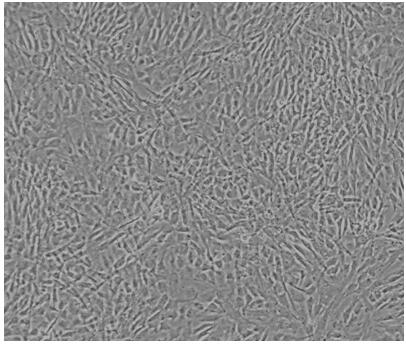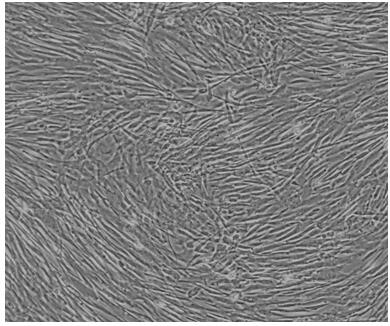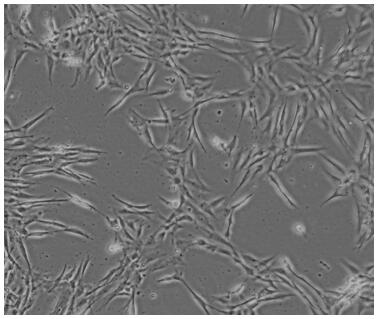Method for culturing endometrial cells
A technology of endometrium and cells, applied in the biological field, can solve the problems of slow growth and poor passage effect
- Summary
- Abstract
- Description
- Claims
- Application Information
AI Technical Summary
Problems solved by technology
Method used
Image
Examples
Embodiment 1
[0025] Embodiment 1 A method for culturing endometrial cells, the steps are as follows:
[0026] Add 5 mg of stem cell exosome freeze-dried powder to 5 mL of ultrapure water to dissolve, then add 100 mL of DMEM / F12 medium, and then add 5 mL of human albumin (the volume of human serum albumin is the volume of DMEM / F12 medium 5%) to obtain a cell culture system.
[0027] Take 1 ml of cell suspension, add 10 mL of cell culture system, mix, and centrifuge at 1500 rpm for 5 minutes, discard the supernatant, and resuspend the obtained cell pellet to 1 ml with cell culture system, follow 10 4 / cm 2 Inoculate culture flasks at a density of 100%, add them to T150 cell culture flasks, and add 25ml of cell culture system to each culture flask, as the 0th day of cell growth, at 37°C, 5% CO 2 Culture in an incubator, update the cell culture system every 3 days, after the cells grow to the 7th day, the cell density reaches 90%, the cells can be subcultured, the cells are photographed, and...
Embodiment 2
[0036] Add 1 mg of stem cell exosome freeze-dried powder to 5 mL of ultrapure water to dissolve, then add 100 mL of DMEM / F12 medium, and then add 5 mL of human albumin (the volume of human serum albumin is the volume of DMEM / F12 medium 5%) to obtain a cell culture system. Take 1 ml of cell suspension, add 10 mL of cell culture system, mix, and centrifuge at 1500 rpm for 5 minutes, discard the supernatant, and resuspend the obtained cell pellet to 1 ml with cell culture system, follow 10 4 / cm 2 Inoculate culture flasks at a density of 100%, add them to T150 cell culture flasks, and add 25ml of cell culture system to each culture flask, as the 0th day of cell growth, at 37°C, 5% CO 2 The cell culture system was updated every 3 days. After the cells grew to the 7th day and the cell density reached 75%, the cells were photographed to observe the cell growth status. In addition, after 7 days of culture, the absorbance of 12 hours was 1.062.
Embodiment 3
[0038] Add 10 mg of stem cell exosome freeze-dried powder to 5 mL of ultrapure water to dissolve, then add 100 mL of DMEM / F12 medium, and then add 5 mL of human albumin (the volume of human serum albumin is the volume of DMEM / F12 medium 5%) to obtain a cell culture system. Take 1 ml of cell suspension, add 10 mL of cell culture system, mix, and centrifuge at 1500 rpm for 5 minutes, discard the supernatant, and resuspend the obtained cell pellet to 1 ml with cell culture system, follow 10 4 / cm 2 Inoculate culture flasks at a density of 100%, add them to T150 cell culture flasks, and add 25ml of cell culture system to each culture flask, as the 0th day of cell growth, at 37°C, 5% CO 2 Cultured in an incubator, and the cell culture system was updated every 3 days. After the cells grew to the 7th day and the cell density reached 80%, the cells were photographed to observe the growth status of the cells. In addition, after 7 days of culture, the absorbance at 12 hours was 1.657. ...
PUM
| Property | Measurement | Unit |
|---|---|---|
| absorbance | aaaaa | aaaaa |
| absorbance | aaaaa | aaaaa |
| absorbance | aaaaa | aaaaa |
Abstract
Description
Claims
Application Information
 Login to View More
Login to View More - R&D Engineer
- R&D Manager
- IP Professional
- Industry Leading Data Capabilities
- Powerful AI technology
- Patent DNA Extraction
Browse by: Latest US Patents, China's latest patents, Technical Efficacy Thesaurus, Application Domain, Technology Topic, Popular Technical Reports.
© 2024 PatSnap. All rights reserved.Legal|Privacy policy|Modern Slavery Act Transparency Statement|Sitemap|About US| Contact US: help@patsnap.com










